
James Benjamin Blish was an American science fiction and fantasy writer. He is best known for his Cities in Flight novels and his series of Star Trek novelizations written with his wife, J. A. Lawrence. His novel A Case of Conscience won the Hugo Award. He is credited with creating the term "gas giant" to refer to large planetary bodies.
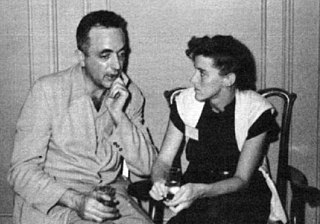
Katherine Anne MacLean was an American science fiction author best known for her short fiction of the 1950s which examined the impact of technological advances on individuals and society.

The Three Stigmata of Palmer Eldritch is a 1965 science fiction novel by American writer Philip K. Dick. It was nominated for the Nebula Award for Best Novel in 1965. Like many of Dick's novels, it utilizes an array of science fiction concepts and explores the ambiguous slippage between reality and unreality. It is one of Dick's first works to explore religious themes.
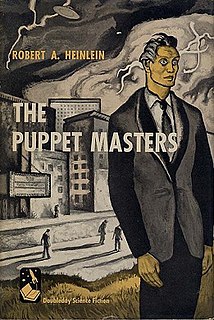
The Puppet Masters is a 1951 science fiction novel by American writer Robert A. Heinlein, in which American secret agents battle parasitic invaders from outer space. It was originally serialized in Galaxy Science Fiction.

Algirdas Jonas "Algis" Budrys was a Lithuanian-American science fiction author, editor, and critic. He was also known under the pen names Frank Mason, Alger Rome, John A. Sentry, William Scarff, and Paul Janvier. He is known for the influential 1960 novel Rogue Moon.

Robert Silverberg is an American author and editor, best known for writing science fiction. He is a multiple winner of both Hugo and Nebula Awards, a member of the Science Fiction and Fantasy Hall of Fame, and a Grand Master of SF. He has attended every Hugo Awards ceremony since the inaugural event in 1953.

Children of the Atom is a 1953 science fiction novel by American writer Wilmar H. Shiras, which has been listed as one of "The Most Significant SF & Fantasy Books of the Last 50 Years, 1953–2002." The book is a collection and expansion of three earlier stories, the most famous of which is the novella "In Hiding" from 1948, which appeared on several "Best SF" lists. The book's plot focuses on children with superhuman intelligence.
Walter Braden "Jack" Finney was an American writer. His best-known works are science fiction and thrillers, including The Body Snatchers and Time and Again. The former was the basis for the 1956 film Invasion of the Body Snatchers and its remakes.

The Algebraist is a science fiction novel by Scottish writer Iain M. Banks, published in print in 2004. It was nominated for a Hugo Award for Best Novel in 2005.

Against the Fall of Night is a science fiction novel by British writer Arthur C. Clarke. Originally appearing as a novella in the November 1948 issue of the magazine Startling Stories, it was revised and expanded in 1951 and published in book form in 1953 by Gnome Press. It was later expanded and revised again and published in 1956 as The City and the Stars. A later edition includes another of Clarke's early works and is titled The Lion of Comarre and Against the Fall of Night. In 1990, with Clarke's approval, Gregory Benford wrote a sequel titled Beyond the Fall of Night, which continues the story arc of the 1953 novel. It is generally printed with the original novel as a single volume.

The Demolished Man is a science fiction novel by American writer Alfred Bester, which was the first Hugo Award winner in 1953. An inverted detective story, it was first serialized in three parts, beginning with the January 1952 issue of Galaxy Science Fiction, followed by publication of the novel in 1953. The novel is dedicated to Galaxy's editor, H. L. Gold, who made suggestions during its writing. Bester's title was Demolition!, but Gold talked him out of it.
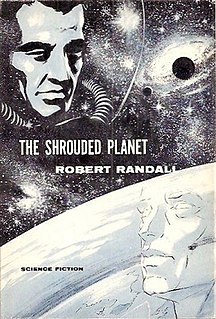
The Shrouded Planet is a 1957 science fiction novel published under the name "Robert Randall", actually the collaborative work of American writers Robert Silverberg and Randall Garrett. It consists of three linked stories, each originally published separately in the magazine Astounding Science Fiction. Linking chapters were added for book release. The first book printing, by Gnome Press in New York, was small and did not sell well. This and the sequel novel, The Dawning Light, were reprinted 25 years later.
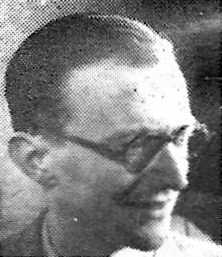
James Murdoch MacGregor, was a Scottish journalist and author best known for writing science fiction under the pen name J.T. McIntosh.

The Stars Are Ours! is a 1954 science fiction novel by American writer Andre Norton. It describes the first interstellar voyage, undertaken to escape the tyranny that rules the Earth. Norton wrote a sequel, Star Born, which was published in 1957.
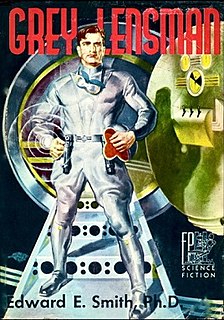
Gray Lensman is a science fiction novel by American writer E. E. Smith. It was first published in book form in 1951 by Fantasy Press in an edition of 5,096 copies. The novel was originally serialized in the magazine Astounding in 1939. Gray Lensman is the fourth book in the Lensman series and the second to focus on the adventures of Lensman Kimball Kinnison.
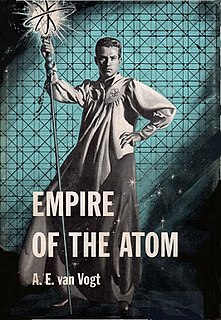
Empire of the Atom is a science fiction novel by Canadian-American writer A. E. van Vogt. It was first published in 1957 by Shasta Publishers in an edition of 2,000 copies. The novel is a fix-up of the first five of van Vogt's Gods stories, which originally appeared in the magazine Astounding. The remaining Gods stories are combined in the sequel The Wizard of Linn. A genealogical chart of the ruling family of the Empire of Linn is included.

The Shrinking Man is a science fiction novel by American writer Richard Matheson, published in 1956. It has been adapted into a motion picture twice, called The Incredible Shrinking Man in 1957 and The Incredible Shrinking Woman in 1981, both by Universal Pictures. The novel was retitled The Incredible Shrinking Man in some later editions.
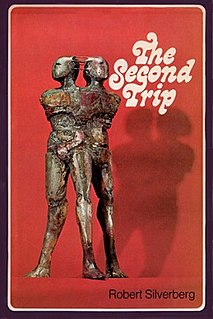
The Second Trip is a 1972 science fiction novel by American writer Robert Silverberg. Prior to its publication by Doubleday, it was published in serialized form in Amazing Stories from July to September 1971.
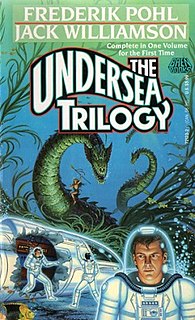
The Undersea Trilogy is a series of three science fiction novels by American writers Frederik Pohl and Jack Williamson. The novels were first published by Gnome Press beginning in 1954. The novels were collected in a single omnibus volume published by Baen Books in 1992. The story takes place in and around the underwater dome city called Marinia. The hero of the stories is cadet Jim Eden of the Sub-Sea Academy.

Planet of Light is a science fiction novel by American writer Raymond F. Jones, first published in 1953 by the John C. Winston Co. as part of its 35-book set of juvenile novels. Written as a sequel to Son of the Stars, the story follows Ron Barron and his family as they are taken to a planet in the Great Galaxy of Andromeda to participate in a meeting of an intergalactic analogue of the United Nations. They face the question if Earth is ready to join an intergalactic society.



















